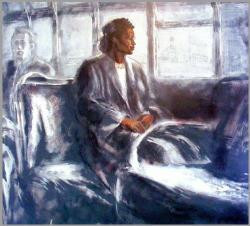Bryan Hill
Visual Arts Teacher
Mary B Neal Elementary School
Primary (5 to 8 years old), Elementary (9 to 12 years old)
Visual Arts
:
A Graduate of Virginia Commonwealth University (Richmond, VA) with a Bachelors of Fine Art in Art Education and a Masters of Science in Administration from Trinity University (Washington, DC) in Education Administration as well as a second masters degree in Art Education from The University of Florida. Currently an elementary visual arts teacher in Charles County (MD) Public School.
Bryan Hill's collections
Presidential Backgrounds as Portraiture
<p>In this collection, I take a look at the objects and the atmospheric space as the major components to portraiture as opposed to the figure. This approach allows the participants to draw conclusions of the subject when no prior knowledge may be known of the subjects themselves. This activity tests the viewer to first look beyond the traditional portrait and begin to have a conversation about the setting and the situation that the portrait holds. </p>
<p>Portraits with multifaceted backgrounds with objects are most effective when using this strategy. Thus, the rationale that the 44 portraits in Americans President’s is used for this collection, not everyone knows everything there is to know about the Presidents of the United States of America but this collection will give viewers a snapshot of their lives in a particular moment. </p>
<p> The five Presidents highlighted in this particular collection are: George Washington, Martin Van Buren, Grover Cleveland, Herbert Hoover, John F. Kennedy and Barack Obama</p>
 Bryan Hill
Bryan Hill
7
Rosa Parks: Compared to Herself
<p>Created in conjunction with participating in the <strong>Learning to Look: Summer Teacher Institute</strong> [June 2017]</p>
<p><strong>Rosa Parks</strong></p><p>With a courageous act of civil disobedience, Rosa Parks sparked a challenge to segregation that culminated in one of the seminal victories of the modern civil rights movement. On December 1, 1955, while traveling on a public bus in Montgomery, Alabama, the seamstress was arrested for refusing the driver's demand that she surrender her seat to a white male passenger. When Parks was convicted of violating local segregation laws, Montgomery's African American community launched a massive one-day boycott of the city's bus system. The boycott expanded with the help of Martin Luther King Jr. to last 382 days, ending only after the U.S. Supreme Court ruled bus segregation unconstitutional.</p>
<p><strong>How do various art forms effect the way that the viewer interprets different works of art? Some questions to consider are:</strong>
</p>
<ul><li>What are the events occurring in the portrait?</li><li>Do they make a personal connection?</li><li>What is the sitter saying in the portrait?</li><li>What questions does the portrait raise, for future discussions?</li></ul><p><br /></p>
<p>#npgteach #npg</p>
 Bryan Hill
Bryan Hill
5



